Lady Macbeth: ‘We fail? But screw your courage to the sticking place and we’ll not fail!’ (Shakespeare)
Most anglers associate specimen hunting with the continual search for a new personal best. For some of us though, there’s more to a fishing challenge than just the weight; it can be the place itself, and for many years, I’ve indulged a weakness…
There is a particularly large, scenic gravel pit not too far from home that I just can’t stop fishing. It’s well over 100 acres in size, is shared with a sailing club, needs four different tickets to access two thirds of its bankside and is as hard to catch from as any place I’ve ever heard about. Its name (which I will not utter here) can (and does) make grown men go weak at the knees.
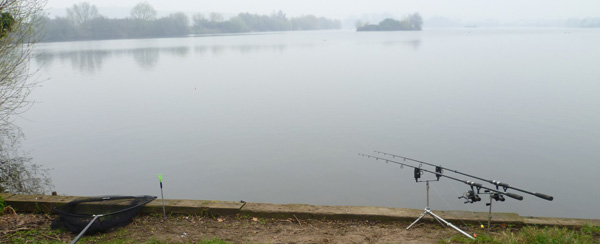
Although it also has some huge, elusive tench and bream I, and the other few diehard fanatics, target the carp and carp anglers have been known to fish it for several seasons without a run. The best and most successful on here reckon on an average of 40 sessions per bite.
Would you be tempted?
For the size of the water, a kilometre at its widest in both directions, there are very few carp, maybe 30 to 40. In all honesty nobody truly knows, nobody ever has and, in all likelihood, nobody ever will. The draw for us all is the unknown. A sluice at the top of the lake and a weir at the bottom mean that fish turn up and disappear without warning. Fish are flooded down into the lake through a system of other lakes and channels and some are lost forever over the weir; we just never know what will turn up, remain or disappear, from season to season.
The swims and the bankside are mostly as natural and beautiful as can be; there are islands, plateaux, bars, channels and a vast expanse of open water, the majority of which is inaccessible and all (non-sailing) boats and bait-boats are banned. Some challenge indeed!
The lake has never been officially stocked to my knowledge, the carp go to over 40lb and are as wild as you could find. Many of them have probably not been caught in years and often fight as though their lives depend on it. Very few see a landing-net often enough to have names.
When I finally decided to take on the challenge of the lake’s carp, after dabbling for a few years for tench and eels, I spent two seasons fishing with some very good carp anglers, regulars who were similarly afflicted with a long-standing, all-consuming passion for this lake where, on average, some of them managed a couple of carp each spring season. I managed a blank or a couple of good tench during those first two seasons but it’s all a learning curve and getting a run from anything was an achievement!
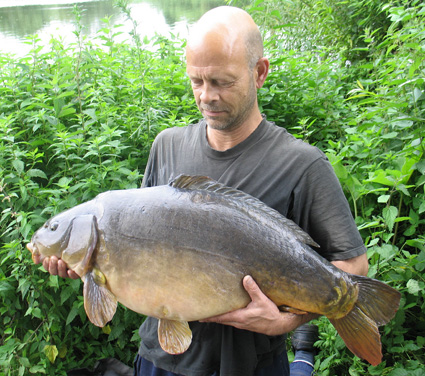 The third season, the carp lads disappeared onto one of the lake’s other hard-to-get tickets and I had to carry the mantle almost on my own in the area they had been fishing with me. A handful of new lads gave it a go for a few sessions, as they always have over the years, but they gave up in somewhat desultory fashion once they realised the fish just weren’t that easy – not even the tench! Most people like to catch something, anything, now and again. It doesn’t come easily here though, it’s a genuine ‘ball-breaker’.
The third season, the carp lads disappeared onto one of the lake’s other hard-to-get tickets and I had to carry the mantle almost on my own in the area they had been fishing with me. A handful of new lads gave it a go for a few sessions, as they always have over the years, but they gave up in somewhat desultory fashion once they realised the fish just weren’t that easy – not even the tench! Most people like to catch something, anything, now and again. It doesn’t come easily here though, it’s a genuine ‘ball-breaker’.
The trick to this big pit carping is really about finding the fish and nailing down their patrol routes. Carp are creatures of habit and after many hours, days, weeks and months of both passive and active observation you can begin to notice patterns of behaviour and then you have a chance to make that work for you.
But that isn’t the only thing you have to get right; the plentiful weed growth on this water – and indeed on many big pits – is so full of natural food for the fish that weaning them off it can take some doing and many’s the day when a large carp or two slowly glide over your bait (or under your rod) without so much as a glance, but thankfully time does give you the edge.
In the spring, prior to spawning, and in summer, post-spawning, their appetites sharpen up and your offerings may start to be accepted, especially since there’s always some bait going in elsewhere on the pit and these fish can, and do, roam from one end to the other in a few hours. To put this into perspective I’d guess, on an average day, there might be from two to six anglers on the entire lake.
The next stage is to be in the right place at the right time, and so the lottery begins…
Last season I had spent two months baiting, watching and waiting with nothing but the occasional line bite for my troubles. I saw plenty of fish as the sunshine always brings their dorsal fins to the surface, but could I tempt one, could I hell…
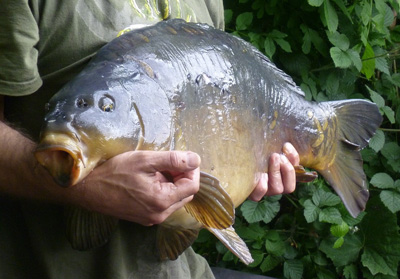 Then I was lying back in the chair mid-morning enjoying the warmth when something took the bait. I was mentally processing how to wrap up the coot and unhook it safely when I picked up the rod and then realised that coots don’t pull that hard!
Then I was lying back in the chair mid-morning enjoying the warmth when something took the bait. I was mentally processing how to wrap up the coot and unhook it safely when I picked up the rod and then realised that coots don’t pull that hard!
The carp just made the edge of some submerged tree branches by the island in front of me but I managed to bully it away and after a decent tussle in the open water I had my prize. All that time I’d spent blanking melted away as I raised my net and celebrated; not the biggest at 22lb but the most important – the first!
Some might have given up at that point and spent their angling hours, to their mind, more productively. I, on the other hand, hungered for more; could I build on this success?
Now I’m not a ‘carper’ and I don’t always do what ‘carpers’ are meant to do. I can normally only fish twice a week and can’t spend days and nights on end climbing trees and pre-baiting all over the place. The following season I tried to take what I’d learned and focus it. One particular thought occupied me in that although the carp seemed to have a rest area behind a line of islands that was inaccessible, perhaps they re-visited their daytime haunts at night when no-one was watching?
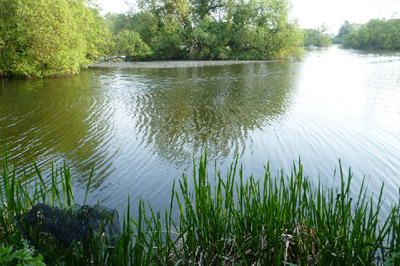 I spent another couple of months blanking and observing – at one time one part of one of the bays had 20 large carp milling around as the growing oppressive heat brought thoughts of spawning to their glands – but no bait could tempt them. They cruised over my zig-rigs and baited spots with glazed eyes and, as always, floaters were impossible to employ due to the bird-life.
I spent another couple of months blanking and observing – at one time one part of one of the bays had 20 large carp milling around as the growing oppressive heat brought thoughts of spawning to their glands – but no bait could tempt them. They cruised over my zig-rigs and baited spots with glazed eyes and, as always, floaters were impossible to employ due to the bird-life.
Despite this lack of interest I continued to persevere and thought I would try a new swim and a couple of new features where I often saw the fish move through – a deeper channel by an island and the edge of a gravel plateau. My tactics were a bed of particles (I use Partiblend) and some good quality freezer boilies with a simple, single, six-inch bottom bait rig. Nothing complicated, although I do pull the hooklink through a PVA mesh stick to stop the hook getting caught in weed; this also disguises the link by covering it once the PVA has dissolved. These fish are so rarely caught that ‘rig-shy’ isn’t in their dictionary; mind you ‘bait’ isn’t in there most of the time either, but they do slip up now and then.
Trundling the gear past a friend fishing at dusk on my way up for yet another session, he told me some carp had been seen taking insects off the top an hour ago, just along from where I planned to be that evening – at least I’m where the fish are.
It’s half past midnight and I stumble through the mozzie-net to pick up the rod in the hazy moonlight. There’s not a lot of fight initially due to the fish immediately burying its head in a wall of weed, but I get it in despite it ‘kicking off’ nearer the net. No, not a tench after all, but a 24lb 10oz mirror, a wonderful way to start and bring some much-needed confidence back..
Two carp in two seasons? I must be dreaming!
The next session I’m watching the ducks diving at 7am and while waiting for one of them to pick up the bait something unseen on the other patch, thirty yards away, sets off the alarm. There are some nasty sunken branches to the left of my swim and this fish feels heavy enough to make them if I’m not careful; sheer brute force and a little skill wins the day – and I can hardly lift the net.
It’s one of the bigger fish at just over 36lb and I can’t quite believe my luck. I’m later told that this one’s been named ‘The Football’. Despite my elation I managed to stop short of heading it back in the water…do I care about ‘names’? No, it’s only an aid to identification after all.
A week later, I pack up for work after a bite-less night but vow to return later as, on leaving, I see four carp move into the vicinity. Vindicated, I manage two from the same spot the following morning. Another 24lb fish at 3am, which was a typical specimen for the place being long, lean and fighting fit and then what must be one of the smallest carp in the pit at a mere 12lb, some five hours later.
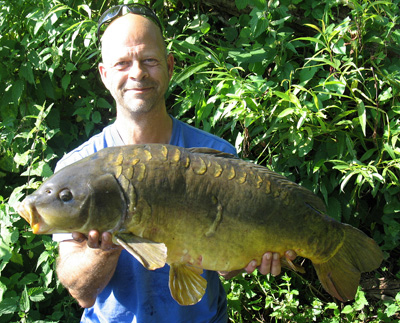 This was all going rather better than I expected and my mate, who’s been coming up to photograph all the fish, is clearly gobsmacked. He’s a very good and experienced all-rounder, with a passion for this type of carping and once spent 90 days and nights on this lake for six runs and three fish; he knows what it’s like!
This was all going rather better than I expected and my mate, who’s been coming up to photograph all the fish, is clearly gobsmacked. He’s a very good and experienced all-rounder, with a passion for this type of carping and once spent 90 days and nights on this lake for six runs and three fish; he knows what it’s like!
The best of all was the fifth and last carp of this particular flurry; the violence of the initial run at dawn spun the Delkims round and it fought absolutely every inch of the way in. I’ve rarely had such a battle with a fish of any species; at 25lb it wasn’t the biggest of the lake’s residents, but a dark, long, lean mirror and one hell of an attitude.
As I slowly exposed it on the mat from out of the weigh sling, preparatory to some trophy shots, it flapped itself with incredible vigour straight out of my hands, off the mat and back in the lake in one fluid movement leaving me sprawled on the bank with empty hands – I never stood a chance of a photo. After my mate had stopped laughing, we recalled other instances we knew of on this lake where anglers had had to return carp un-photographed due to their absolute panic, post-capture. These are wild fish in every sense of the word and catching one is a privilege and an achievement, no matter what the weight…or the wait.
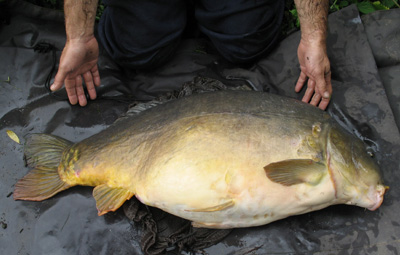 Lesson learnt for next time though; point the fish away from the lake!
Lesson learnt for next time though; point the fish away from the lake!
One of the most experienced and successful guys I carped here with described getting to know this lake as, “Peeling the individual layers off an onion” and I know what he meant. Each year you have to learn afresh all over again. Getting to grips with a big pit takes time, dedication, observation and willpower. It’s challenging nature as well as your own abilities, you’re mostly left alone by other anglers as there’s very little pressure on the water and consequently every twitch of the line by an unseen fish triggers the adrenaline. The thought is constantly lurking in the back of your mind, “Could there be unknown monsters here?”
And sometimes, there are…













